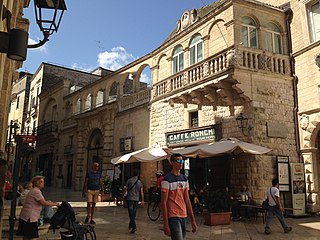
Gaetano Filangieri was an Italian jurist and philosopher.

Altamura is a town and comune of Apulia, in southern Italy. It is located on one of the hills of the Murge plateau in the Metropolitan City of Bari, 45 kilometres southwest of Bari, close to the border with Basilicata. As of 2017, its population amounts to 70,595 inhabitants.

The Diocese of Altamura-Gravina-Acquaviva delle Fonti is a Latin Church diocese of the Catholic Church in Apulia, southern Italy, 40 km south-west of the coastal city of Bari. In 1986. the territorial prelature of Altamura e Acquaviva delle Fonti was united with the diocese of Gravina. The present diocese is a suffragan of the archdiocese of Bari-Bitonto.

The church of Santi Severino e Sossio and the annexed monastery are located on via Bartolommeo Capasso in Naples, Italy.

Antonio Mongitore was a Sicilian presbyter, historian and writer, known for his works about the history of Sicily. He was also canon of the cathedral chapter of Palermo.

Luca de Samuele Cagnazzi was an Italian archdeacon, scientist, mathematician, political economist. He also wrote a book about pedagogy and invented the tonograph.

The Altamuran Revolution was a three-month period of self-government of Italian town Altamura, right after the birth of the Parthenopean Republic which ousted the Bourbons and the Kingdom of Naples. The city of the Kingdom of Naples was then defeated and taken by the so-called Sanfedisti, led by cardinal Fabrizio Ruffo, after a battle on the city walls. After being defeated, most Altamurans managed to flee through Porta Bari, one of Altamura's main gates.

Gioacchino de Gemmis was a Catholic bishop, archpriest, prelate and rector of the University of Altamura. He's best known for his role in the so-called Altamuran Revolution (1799), advocating peace and helping the refugees, who had fled Altamura after the battle with the Sanfedisti, to be allowed in Terlizzi.

Vitangelo Bisceglia was an Italian botanist, agronomist and professor. He taught inside the University of Altamura. Because of his being a polymath, he's been described as "an encyclopedic spirit, the honor of the Muses".

The University of Altamura was a former university located in Altamura, Apulia, Kingdom of Naples. It was established in Altamura in 1747 by Charles III of Bourbon, following the idea of the archpriest of Altamura Cathedral Marcello Papiniano Cusani. It was officially closed in 1812, mainly due to the lack of funds, even though some documents kept inside library Archivio capitolare in Altamura show that professors continued to teach until 1821.

Ottavio Serena was an Italian politician, judge, prefect and historian. He is known in his hometown Altamura for his works about local history, such as the Altamuran Revolution (1799). His contribution and the testimonies he collected allowed to shed light on some historical events (such as the killing of Giovanni Firrao and on legendary toponyms.
Giuseppe Maria Giovene was an Italian archpriest, naturalist, agronomist, geologist, meteorologist, entomologist and ichthyologist. He is best known for his studies on the "nitrosity" of Pulo di Molfetta, which made him famous abroad, so as to be cited and appreciated by many Italian and foreign scholars, including Eberhard August Wilhelm von Zimmermann in a French publication.
Biagio Cusano was an Italian Marinist poet and professor of law. The date of his birth is currently unknown. He is best known for being Gennaro Cusano's uncle and Marcello Papiniano Cusani's grand uncle.
Onorato Candiota was an Italian professor of philosophy and math at the Real Convitto di Bari, in Bari, Italy. He lived between the 18th and 19th centuries. The exact dates and places of birth and death are currently unknown, even though it is known that he was from Altamura, Italy. He's best known for his participation in the so-called Altamuran Revolution (1799). He died short after 1808.

The Liceo classico Luca de Samuele Cagnazzi is an Italian high school located in piazza Zanardelli 30, Altamura, Italy, close to the church Chiesa di San Domenico. It is named after Italian scientist Luca de Samuele Cagnazzi.

Domenico Sacchinelli was an abbot of the Catholic Church. He is best known for having followed and helped Fabrizio Ruffo and the Sanfedisti army to restore the Kingdom of Naples and the Bourbon dynasty, after the short-lived Parthenopean Republic (1799). In 1836, after a few decades, he published his memoirs of that period, titled Memorie storiche sulla vita del cardinale Fabrizio Ruffo.
Giuseppe Carlucci was an Italian professor and astronomer. He was one of the first professors teaching at the University of Altamura (1747-1812).

Antonio Bulifon (1649-1707) was a French printer working in Naples. As a publisher Bulifon was "fundamentally important for the diffusion of women's poetry" in Italy.

Pasquale Marco Carcani was an Italian scholar, philologist and jurist. He was also known by his pseudonym Sofista Pericalle.















